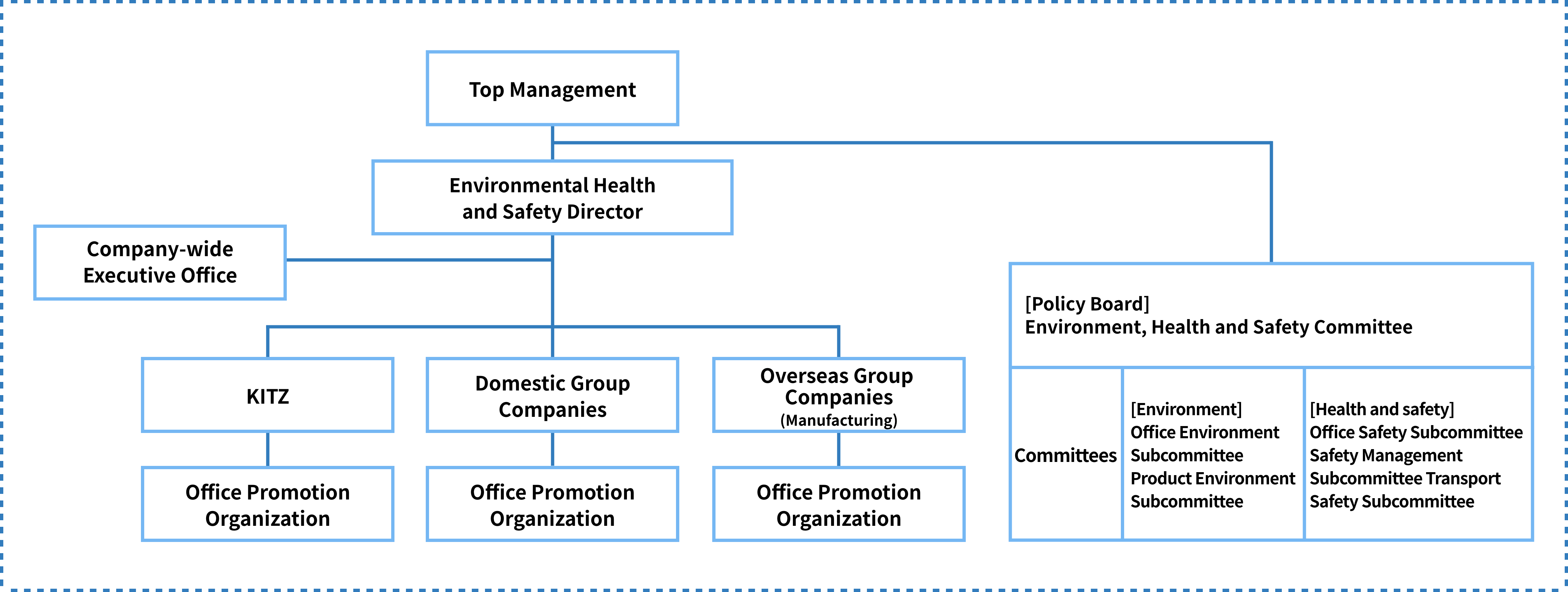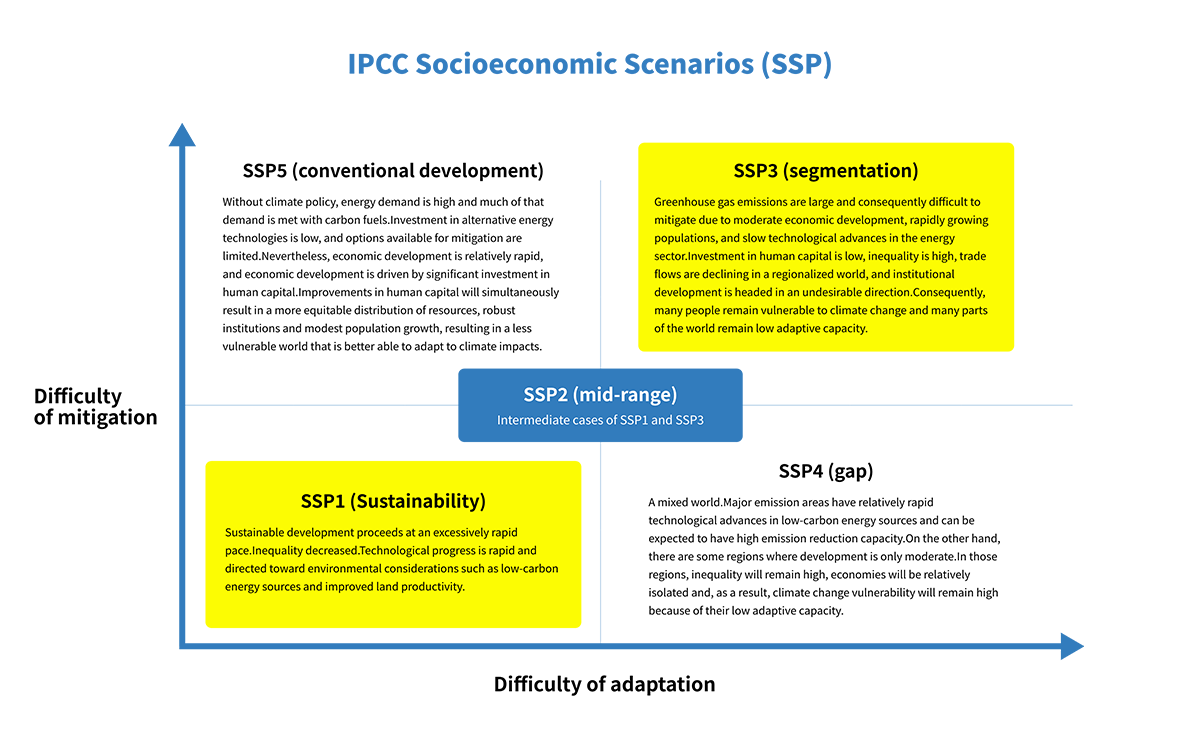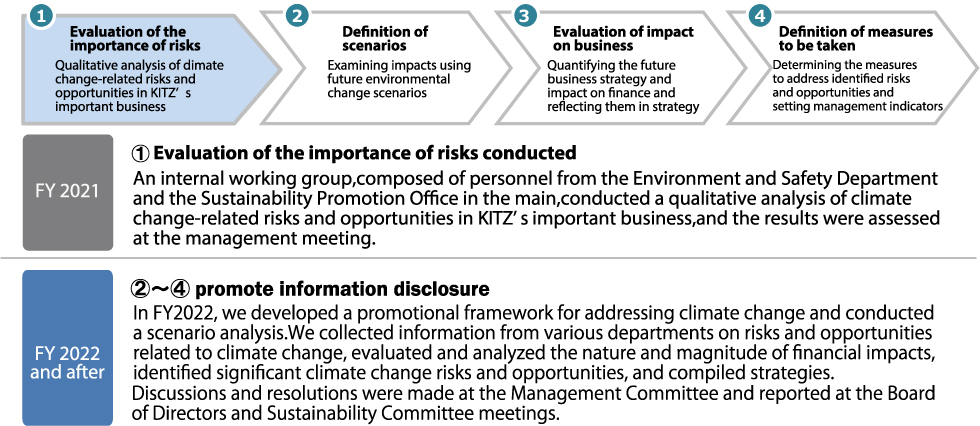Responding to climate change
(Disclosure based on TCFD recommendations)
KITZ identifies risks and opportunities related to climate change and promotes their disclosure based on TCFD recommendations.
In order to make step-by-step improvement in the information disclosure on the financial impact that climate change would exert on business activities, KITZ expressed its agreement with the Task Force on Climate-Related Financial Disclosures (TCFD) in December 2021.
We will promote data-based analyses in stages, grasp the risks and opportunities related to climate change, and increase the quality and quantity of information disclosure based on TCFD Recommendations.

Governance
In its Long-term Management Vision, KITZ places sustainability management at the core of its management strategy.
We are advancing the “3ZERO(Triple Zero)” long-term environmental vision, aiming to achieve zero CO₂, zero environmental impact, and zero risk.
The progress and results of the major items in the Long-term Environmental Vision and the disclosed environmental goals are reviewed at the management meeting composed of Senior Executive Officers and Executive Officers, where decisions are made on the direction, issues to be addressed, and particularly important measures.
The Sustainability Committee, chaired by the President and Representative Executive Officer, shares key themes and KPIs of sustainability management, disseminates the challenges and measures of each company and division across the group, and manages progress toward achieving the goals. Additionally, it operates as a decision-making body for the overall policies of sustainability management.
Governance System for Environment, Safety and Health
- The Environment, Safety and Health Committee, chaired by the Senior Executive Officers and Executive Officers of KITZ and the presidents of Group companies, has been established to confirm the establishment of environmental, health, and safety measures and targets, performance evaluations, and the status of compliance with laws and regulations, and to discuss measures to resolve issues.
- The director in charge of environmental, health, and safety reports to the Board of Directors on the status of implementation of the Long-Term Environmental Vision, progress management, and investment in environmental facilities.

Strategy
Scenario analyses
The scenario analyses conducted this time assumed future temperatures of 1.5°C to 2°C and an increase of 4°C based on the scenarios presented in IPCC Sixth Assessment Report (AR6).
IPCC socio-economic scenarios (SSP) show how much temperature increase is suppressed by future socio-economic development. The world where the temperature is kept within 1.5°C to 2°C is defined as SSP1 and the world where the temperature rises by 4°C is defined as SSP3.
Generally, SSP1 has the greatest transition risk and SSP3 has the greatest physical risk. KITZ selected the tough scenarios with the highest risk for both transition risk and physical risk. Opportunities are critical in both scenarios. In KITZ, we selected SSP1 with more opportunities.

Scenario Analysis Results-Transition Risk
- Legend of financial impact:
-
- Major: There is an impact on the business, and it is assumed that some response needs to be considered as soon as possible.
- Medium: There is an impact on the business, and it is assumed that some kind of response needs to be considered.
- Small: It is assumed to have a considerably lower impact, although it may have a business impact.
| KITZ Climate-related risks | In KITZDetails of financial impact | In KITZDegree of financial impact | KITZ Response | |
|---|---|---|---|---|
| Government Policy ・Laws and regulations |
|
|
|
|
| Technology |
|
|
|
|
| Market |
|
|
|
|
| Reputation |
|
|
|
|
Scenario Analysis Results-Physical Risk
| KITZ Climate-related risks | In KITZDetails of financial impact | In KITZDegree of financial impact | In KITZDegree of financial impact | |
|---|---|---|---|---|
| Acute・ Chronic |
Acute: Severe abnormal weather
Chronic: Increase in mean temperature, change in precipitation pattern
|
|
|
|
Scenario Analysis Results-Opportunities
- Legend of financial impact:
-
- Major: Potential for new or further business development at an early stage or in concrete terms
- Medium: New or potential for further business development
- Small: It is assumed that there is a possibility of business development, but there is no significant impact.
| KITZ Climate-related opporunities | In KITZDetails of financial impact | In KITZMagnitude of opportunity | KITZ Response | |
|---|---|---|---|---|
| Finished goods Service |
|
|
|
|
Strategic pillar
- We will develop businesses aimed at decarbonization based on the following three strategies for addressing climate change issues.
- ①Contribute to climate-change mitigation through reduced CO₂ emissions and efficient resource and energy use
- ②Contribute to climate-change mitigation by promoting the reduction of CO₂ emissions through our products.
- ③Work with communities to mitigate climate change and contribute to the creation of a sustainable future
Specific strategy content
- ①Contribute to climate-change mitigation through reduced CO₂ emissions and efficient resource and energy use
-
- ・Promoting energy conservation at our plants through unit energy consumption management:Further promotion of normal energy conservation activities (e.g. switching to LED lights, setting air conditioners at appropriate levels, etc.), introduction of high-efficiency equipment and facilities, etc.
- ・Promotion of renewable energy use :Procuring CO₂-free electricity and installing photovoltaic power generation facilities
- ・Indirect reduction of CO₂ through reduction of environmental impact:Reduction of water consumption and landfill waste through unit requirement control
- ②Contribute to climate-change mitigation by promoting the reduction of CO₂ emissions through our products.
-
- ・Support for the construction of a hydrogen supply chain for decarbonization through the development of fluidic control technologies and materials:In all processes of hydrogen production, transport, storage, and utilization, use of KITZ’s fluidic control technology and material development will be utilized to enter the hydrogen market, where social packaging is advancing.
Concrete activities: development in the hydrogen station market by package units, entry into small-scale local production and local consumption type green hydrogen energy chain business, entry into large-scale liquefied hydrogen demonstration plant, and execution of research and development for entry into the hydrogen aircraft market. - ・Assistance for “transition to decarbonization” in all sectors:Support the transition of suppliers to decarbonization and low-carbon business* by utilizing KITZ’s fluidic control technique and material-development.
Specific activities include promoting and supporting the use of alternative fuels such as hydrogen and ammonia by developing fluid-control technologies and materials, responding to increased demand for LNG plants, and reducing customers’ CO₂ emissions by reducing energy loss and extending the service life of valve through appropriate maintenance.
※”Lower carbon” was defined as promoting the use of “natural gas” important during the transition to decarbonation. - ・Development of products and systems that contribute to decarbonization:Development and deployment of automated valve for building and industrial facilities by IoT, development and deployment of valve, filters, and systems with flow control functions leading to energy conservation by customers, and development of valve products and systems related to CCUS (LCO₂ carriers, etc.).
- ・Support for the construction of a hydrogen supply chain for decarbonization through the development of fluidic control technologies and materials:In all processes of hydrogen production, transport, storage, and utilization, use of KITZ’s fluidic control technology and material development will be utilized to enter the hydrogen market, where social packaging is advancing.
- ③Work with communities to mitigate climate change and contribute to the creation of a sustainable future
-
- ・Development of a Community-Level (Microscale) Hydrogen Utilization System and Implementation of Demonstration Tests
Risk and management
Risk assessment and management system for climate change
In order to continuously reduce climate-related risks, KITZ is responding in accordance with the basic concept of Group risk management. Specifically, the Sustainability Promotion Office, a division under the Sustainability Committee, identifies and assesses key risks related to climate change, and manages the progress of the strategic pillars to be addressed and their KPIs (key performance indicators).
Process of assessing and managing climate change risks

The Legal, Intellectual Property and Risk Management Division plays a central role in identifying important risks from among the assumed risks associated with various business activities, including those related to climate change, and assessing and managing risks using common progress management tools.
Indicators and Targets
- ①Contribute to climate-change mitigation through reduced CO₂ emissions and efficient resource and energy use
Reduce in-house CO₂ emissions by 90% or more from the 2013 level by 2030, and make it carbon neutral by 2050 (promote the long-term environmental vision “3ZERO (triple-zero)”).

- ②Contribute to climate-change mitigation by promoting the reduction of CO₂ emissions through our products.
- ③Work with communities to mitigate climate change and contribute to the creation of a sustainable future
※②, For item ③, we plan to set indicators and targets based on the status of our own initiatives in the future.
※For domestic and overseas Group companies, we plan to set indicators and targets based on the status of future initiatives.
KPI target value
| Base year | KPI target value | ||||
|---|---|---|---|---|---|
| FY2013 |
FY2024 (Published in February 2022) |
FY2024 (Published in February 2024)※ |
FY2030 | ||
| CO₂ Emissions(t) | Scope1・2 | 65,933 | 13,187 | 6,593 | 6,593 |
| CO₂ Reduction Rate(%) | – | ▲80.0 | ▲90.0 | ▲90.0 | |
※ The target was achieved in FY2023 ahead of schedule, so the relevant target was raised in February 2024.
Results
| Base year | Results | |||
|---|---|---|---|---|
| FY2013 | FY2022 | FY2023 | ||
| CO₂ Emissions(t) | Scope 1 | 12,214 | 9,903 | 2,913 |
| Scope 2 | 53,719 | 11,656 | 6,340 | |
| Total | 65,933 | 21,561 | 9,284 | |
| CO₂ Reduction Rate(%) | – | ▲67.2 | ▲85.9 | |

Contact us
For inquiries about product technology, product purchases,
catalogs, and quality
